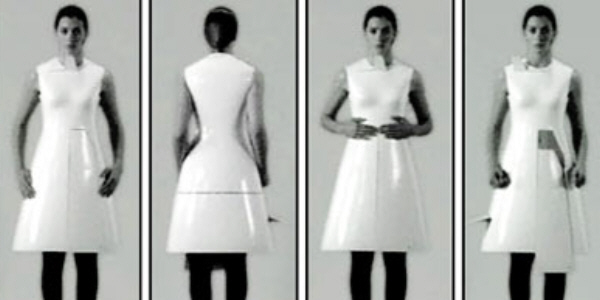
A pioneer of fashion, Chalayan's ‘From Fashion and Back’ exhibition explores the conceptual work he has become renowned for and catalogues some of his most captivating catwalk collections. One of his most famous installations, ‘Repose’ is included in the exhibition – a life size aeroplane wing that uncompromisingly juts out from a wall. The wing was originally commissioned in 2006 by Swarovski and is complete with moving parts and flashing lights. Look closely and you’ll see rows of sparkling Swarovski crystals, illuminated by LED lights, all glittering inside.
Before being greeted by the solitary wing, Chalayan’s latest collection ‘Inertia’ (as recently featured in Dazed and Confused magazine) sits pride of place at the exhibition entrance. The collection is based on the exploration of speed with each dress examining the stages of a car crash - from initial impact to the aftermath of shattered remains. Immediately, I was drawn to touch the three spiked dresses. However, contradictory to their look, each dress is made from soft foam which I can’t help wonder if this is used in reference to the human body and it’s fragility in the event of a crash.
Next door, a group of figures appear to be painting the walls. A set of three mannequins and a fourth central one, dominate the room. They are dressed in Chalayan’s 1998 ‘Panoramics’ winter collection that was designed to deliberately confuse and make the clothes difficult to define. Part ethnic costume, part uniform and part insect, the clothes create hybrids symbolising camouflage and the loss of individuality. Continuing this theme, the mannequins’ absurd millenary has consumed their heads as equally as the task of painting the wall has consumed them. This surreal sight provokes you to realise how impossible it is to ignore Chalayan’s genius mind and not wonder from where he draws such otherworldly inspiration.
Throughout the exhibition videos of collections from the last fourteen years roll on. Amongst others, I chose to watch ‘Ambimorphous’ from autumn/winter 02. The catwalk show follows the transformation from traditional Turkish costume to a simple black dress and coat in varying stages; a reference towards cultural change and a nod to Chalayan’s multi-cultured upbringing as a Turkish Cypriot. The show closes with the same dress that started the collection and once more transforms back to full Turkish costume.
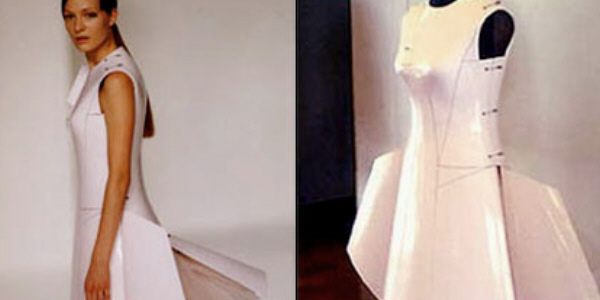
With countless runway reels to choose from, I chose rather to focus on the exhibition installations and loaned garments. For anyone who does the same (or just wants to loose themselves in his work again) Chalayan’s website holds comprehensive coverage of each collection in the form of both photographs and original catwalk videos.
Moving on, it was the rare opportunity to watch Chalayan’s short film ‘Place To Passage’ that stole my attention. First screened in London’s Truman Brewery’s in 2003, the film documents a seemingly soul-less woman’s journey from London to Istanbul in a self-contained, futuristic pod. Five curved flat screens play host to the twelve-minute film, which explores the idea of speed and technology. The pod provides the passenger food and water and throughout the journey, passes scenes of industrial architecture and the Israeli Bosphorus river before docking in a car park. Continuing on his often-used architectural and technological theme, the famous chair dress from Chalayan’s 1999 ‘Geotropics’ collection sits next to the five screens. This structural, surreal outfit was designed to blur the edges between human and object (similarly as the pod in Place to Passage). The ergonomic chair morphs into both garment and model making it seem no longer a chair but an extension of the body.
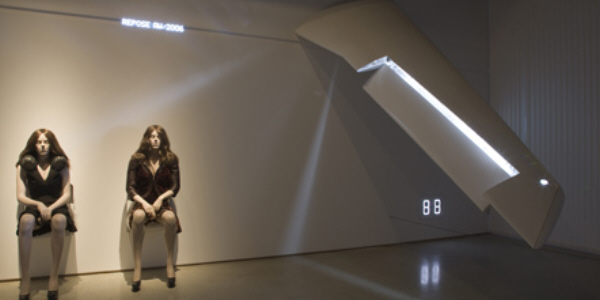
In a small, dimly lit room, one of the highlights of the exhibition - the ‘Readings’ collection awaits discovery. The 2000 collection from was also recently shown at the Skin and Bones exhibition at Somerset House in London, celebrating fashion pioneers. This spring summer collection included showpieces consisting of two dresses, a jacket and a hat, each of which were covered in Swarovski crystals and fitted with streams of lasers. Tiny motors attached to each crystal allowed hundreds of lasers to glide and project beams of red light from the garments in multiple directions - a technique previously unused by Chalayan. The inspiration for this collection was derived from the culture of sun worship and the cult of celebrity. The resulting garments with their beams of light were designed to reflect the aura and spectacle of celebrity and as a collection, brought Chalayan to the front line in groundbreaking pattern cutting practices. In addition to his catalogue of previous collections, Readings demonstrated his avant-garde fashion design and prove his enviable ingenuity.
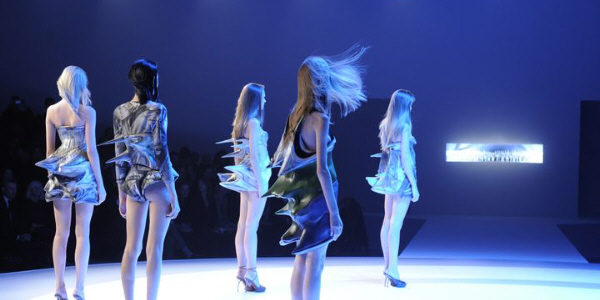
Just as I was about to exit the exhibition, I thought it was odd that I hadn’t seen the amazing ‘Afterwords’ collection from 2000. It included a coffee table that transformed into a skirt and chairs that became dresses. These multi-purpose objects were based on the plight of the refugee and the grief of leaving a home suddenly. Upon retracing my steps, I found the installation of chairs around a corner and a video of the original catwalk show. The video shows a room being stripped of objects as models enter and transform the furnishings into garments, echoing fashion during war and the urgency of retrieving possessions. It was this collection that caught my attention when studying fashion and for me, will always remain one of Chalayan’s key collections.
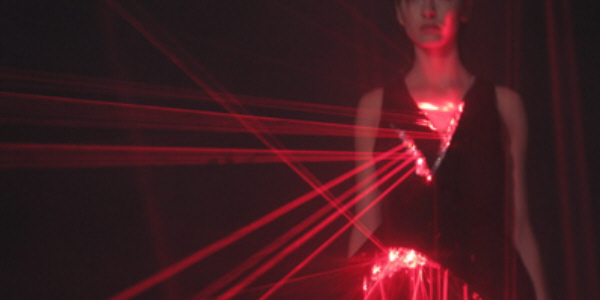
‘From fashion and back’ offers a comprehensive catalogue of each of Hussien Chalayan’s haute couture collections and the topics studied to envision them. It really is a rare opportunity to view such a wealth of his impeccable work and to be given the opportunity to crawl inside and attempt to understand such a creative mind. From dresses that resemble airplanes in both paper and mechanical form to laser beam and exploding garments, each of Hussien Chalayan’s collections tell an epic story. This story and exploration of ethical questions and political subjects inspire and allow him to push the boundaries of fashion, undeniably proving his worth as an artist. It is through this practice that Chalayan undoubtedly defines his work not only fashion, but indeed and as a form of art, of which will continue to inspire students, designers and many more for decades to come.
Clare Scott





